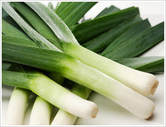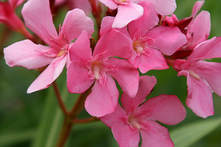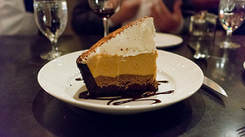|
Ozark Green Thumb BCMG Monthly e-Newsletter |
|
|
|
In this month’s article I want to mention some things gardeners need to be considering for June.
The following is a garden checklist:
For more information on any of the above points, contact the University of Arkansas Division of Agriculture Cooperative Extension Service at 425-2335.
1 Comment
Subject: Cotton in flower beds, gardens, educational displays, and other non-commercial plantings
Currently ALL non-commercial cotton MUST be registered through the Plant Board for approval! While a boll weevil has not been caught in Arkansas for several years, we are still in an active boll weevil eradication program. This requires the Arkansas Boll Weevil Eradication Foundation (ABWEF) to monitor all cotton plantings statewide, sample or trap for occurrence of boll weevils, and take the appropriate measures should a weevil be trapped. All plantings of cotton in the state are subject to fee on an acre basis to defray the expense of the program. The collection of fees is coordinated by the Arkansas State Plant Board (ASPB). To facilitate this process, Plant Board regulations are currently in place that prohibit ornamental (non-commercial) cotton in the entire state of Arkansas. However, the ABWEF with approval from the ASPB will work with individuals and organizations to place traps where they have cotton plants for educational purposes. This requires some additional effort by ABWEF personnel and those conducting the cotton educational program or exhibit. These sites need to be made known to the ABWEF personnel as soon as possible to ensure proper mapping and timely deployment of boll weevil traps to ensure the continued success of the program. Those who wish to conduct a cotton educational program or exhibit that includes the planting and growing of cotton are encouraged to contact Regina Coleman ([email protected]), Executive Director of ABWEF. She will need information on proposed planting date, location, and contact information for the person or group overseeing the project. We appreciate your interest in conducting cotton educational programs in Arkansas. Feel free to contact me or your local county Extension agent for additional resources for your cotton educational program. Regards, Bill Bill Robertson, Ph.D. Professor, Cotton Extension Agronomist University of Arkansas System Division of Agriculture Newport Extension Center 649 Jackson 917 Newport, AR 72112 Cell (501) 425 0549 Janet Carson Consumer Horticulture Specialist Arkansas Master Gardener Coordinator 2301 South University Ave Little Rock, AR 72204 [email protected]  Almost any time of year is good for growing leeks, the most upright members of the onion family. Summer leeks are fast to grow from seed started indoors in late winter, or you can start leek seedlings in late summer to grow from fall to spring. This guide also includes descriptions of the types of leeks to try. Easy to grow and welcome in any recipe that calls for onions, leeks (Allium ampeloprasum var. porrum) allow you to grow oniony crops all year in your kitchen garden. Summer leeks are ready to pull only 60 days after planting, weeks before bulb onions are ready. Slower-growing leek varieties reach maximum size in fall and early winter. Leeks grow best in cool climates, or you can grow them as a fall-to-spring crop where summers are hot. Growing leeks requires moist, fertile soil with a pH between 6.0 and 7.0. Winter leeks tolerate more cold than other varieties, so they are good choices for growing leeks through winter. Mature plants can be left in the ground into winter, or you can sow seed in midsummer for transplanting in early fall. These plants will mature in spring. Under good conditions, the shanks of winter leeks such as ‘Bandit,’ ‘Blue Solaise’ and ‘Siegfried’ exceed 1 inch in diameter. Summer leeks are fast to germinate and grow, though they do not get as large as winter leeks. Maturing 90 days from seeding, or 60 days after transplanting, varieties such as ‘Lincoln,’ ‘King Richard’ and ‘Megaton’ can be grown at close spacing, and pulled anytime after they reach pencil size. Autumn leeks include varieties that mature 100 days from seeding, or 80 days after transplanting. Large and vigorous, varieties such as ‘Lancelot’ and ‘Tadorna’ produce leeks of exceptional quality to harvest in fall, after the weather has cooled. Start leek seeds indoors in late winter provided you can grow them under bright florescent lights. You may also be able to purchase leek seedlings as garden centers or farmers markets in late spring. Harden off seedlings for at least a week before transplanting them to prepared furrows in deeply dug garden beds. Shape 6-inch deep furrows in the cultivated bed, and line the bottom with a standard application of a balanced organic fertilizer. Refill 1 inch of soil, and set out the leek seedlings in the partially refilled furrow, spacing summer leeks 3 inches apart, fall leeks 4 inches apart and winter leeks 6 inches apart. As the leeks gain size, gradually fill in the furrow and then mound a little loose soil over the base of the plants. Keep leeks carefully weeded, and drench plants with a liquid organic fertilizer when they are 15 inches tall. In dry climates, mulch leeks with grass clippings, chopped leaves or another organic mulch that helps retain soil moisture. Leeks need more water than other garden crops, and should never be allowed to run dry. Use a digging fork to loosen soil around leeks before pulling them as needed in the kitchen. Trim roots to one-half inch, and cut off all but 2 inches of the green tops. Store in plastic bags in the refrigerator for up to two weeks. Before eating, slice leeks lengthwise and rinse under cool running water to remove bits of soil. Excess leeks are easy to dry in a food dehydrator. Leeks that have been exposed to cold winter weather produce flowers in early summer, with ripe black seeds about a month later. When the flower heads dry to tan and the seed covers begin to split, gather the seed heads in a paper bag, and allow them to dry indoors for a week. When thoroughly dry, shatter the seed heads and collect the largest seeds for replanting. Under good conditions, leek seeds will store up to three years. Source: Barbara Pleasant: Mother Earth News
 The purpose of these weekly articles, now in their 17th year, is to report on plants that are grown in Arkansas gardens and the surrounding areas of the mid-South. The normal minimum temperatures of the state range from a frosty minus 10 degrees Fahrenheit (USDA zone 6) in Benton County to a more tepid 10 degrees (zone 8) for the southern tier of counties. Oleander (Nerium oleander), though not especially common in south Arkansas, is sometimes grown and deserves a closer look. Oleander is an evergreen shrub growing to 12 feet tall that belongs to the periwinkle family and has been grown so long in cultivation no one knows for sure its origins. It probably originated in southern Asia but due to human intervention has naturalized from the Mediterranean region to Japan. Though most often grown as a rounded shrub it will become a small tree reaching 20 feet in height in frost-free areas. Its leathery, deep green leaves are usually in a whorl of three on the branch, willow-shaped with an entire margin and 3 to 5 inches long. The sap is clear, viscous and capable of causing dermatitis. Eyes are especially sensitive to contact by the sap. Showy flowers in shades of pink, rose, red, yellow, salmon, orange and combinations of these are to 1.5 inches wide and borne in terminal clusters from new growth in the summer and early fall. Flowers may be single or double, fragrant or not. More than 400 cultivars have been named and about 60 are common in cultivation. Oleander has a reputation for being toxic and several urban legends have sprung up about it. The most common is the troop of boy scouts who was supposedly poisoned by eating hot dogs roasted using branches cut from oleander branches. This incident never happened but does closely resemble a similar report in various gardening books from the 19th century reporting on French soldiers near Madrid during the Peninsular War of 1809 who succumbed after eating meat roasted over a campfire using spits made from oleander. Oleander has a reputation for being toxic and several urban legends have sprung up about it. The most common is the troop of boy scouts who was supposedly poisoned by eating hot dogs roasted using branches cut from oleander branches. This incident never happened but does closely resemble a similar report in various gardening books from the 19th century reporting on French soldiers near Madrid during the Peninsular War of 1809 who succumbed after eating meat roasted over a campfire using spits made from oleander. All parts of oleander are toxic and this plant is often considered the most toxic of the many potentially poisonous plants we grow in our gardens. In a 20-year period from 1985 to 2005, five incidences of oleander related deaths were reported in the United States - with three of these by intentional ingestion, probably with a goal of suicide. Quoting Lankford and Boor in their May 1996 article in “Toxicology”: “The human mortality associated with oleander ingestion is generally very low, even in cases of intentional consumption (suicide attempts).” The remaining two cases of death fall outside of the norm, a pair of adopted 2- and 3-year Russian boys named Alexei and Peter Wiltsey from California. They were found dead in their bedroom on May 4, 2000, after several days of eating oleander leaves from a neighbors bush. According to the toxicologist who oversaw the case, he knew of no other reported cases of children eating enough oleander foliage to cause death. The corners office speculated that the children, perhaps still suffering from malnutrition from their adoption a year earlier from a Siberian orphanage, may have suffered from a condition known as “pica” where malnourished children eat anything, including soil and plants. Domesticated animals, especially horses, are more likely affected by oleander poisoning, especially if prunings are discarded where they can be consumed. Oleander is a tough, easy to grow plant that is best in sunny, well drained sites. Foliage damage usually occurs when winter temperatures fall below 15 degrees F with dieback occurring below 10 degrees F. It can be used for screening, in foundation plantings and as a tall groundcover planting in sloping areas where little attention will be given. Plants are extremely drought tolerant. They have long been favorite patio plants in colder regions where they are grown in large tubs. They can be overwintered indoors in unheated garages where the wintertime temperature does not fall below 15 degrees F, or even in basements where the light level is low and plants wait out the winter in miserable growing conditions. The potential toxicity of oleander is not in question, but because so many of the plants we grow in our gardens are theoretically poisonous, the risk should not be over exaggerated. Attention should be paid to toddlers to protect them from all sorts of dangers, and from the earliest age, children should be taught to not eat anything in the garden that a parent doesn’t specifically say is safe. By: Gerald Klingaman, retired
Retired Extension Horticulturist - Ornamentals Extension News - January 10, 2014  The classic of chocolate and peanut butter makes the perfect marriage in this classic Chocolate Peanut Butter Pie. It's easy as pie to whip up , and better than anything you can buy at the store. INGREDIENTS:
Instructions: 1. Bake pie shell according to package instructions. Let cool.
2. In a medium saucepan, combine pudding mix and milk over medium heat. Stir constantly intil boiling then remove from heat. 3. Pour half the pudding into a small bowl. Add chocolate chips to bowl and stir until chips are completely melted. Pour into pie crust. 4. Add peanut butter chips to remaining pudding and stir until chips are completely melted. Carefully pour peanut butter mixture over chocolate mixture in pie shell. Cover and chill at least 4 hours or untill thoroughly chilled and set. 5. Dress this up by topping with whipped cream and garnishing with miniture peanut butter cups.  This is a tasty side dish that can be prepared in less than 30 minutes. Serves 4 Serving Size: 1 cup
Place brussel sprouts in a bowl. Add a splash of water, cover with a fresh
paper towel and microwave 2-3 minutes. Or you may boil in salted water for about 2 minutes. Place a large, nonstick pan over medium high heat. Add bacon and saute until brown and a bit crispy, about 5 minutes. Drain all but 1 tablespoon of the bacon drippings. If the pan looks too dry, add a splash of water before scraping up your bacon bits. Add brussell sprouts to pan. and saute about 5 minutes, or until they are golden on the outside. Add balsamic vinegar, brown sugar, Dijon mustard and 2 tablespoons water to the pan. Saute for another 1 to 2 minutes. Remove to heat and top with lemon juice. Season to taste with salt and pepper. Nutrition Information: Per Serving: Calories 136, Total Fat 5 g, Sodium 316mg, Carbohydrate 16gm, Fiber 5g, Protein 5g |
Archives
April 2022
|
|
